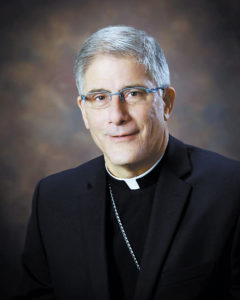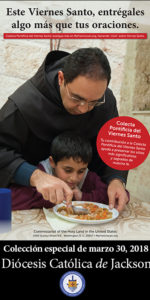
Obispo Joseph Kopacz
Por Obispo Joseph Kopacz
“Que mi gozo esté en ustedes, y su gozo sea colmado” (Jn 15, 11). Estas fueron las palabras de Jesús en el Evangelio del domingo pasado cuando él estaba preparando a sus discípulos para su radical separación de ellos en la cruz. En la misma conversación los invita a una amistad divina y los instruye, o quizá les suplica a “que se amen unos a otros como yo los he amado a ustedes” (Jn 15:12-14). Este pasaje es el camino ideal de la reciente Exhortación publicada del Papa Francisco sobre la santidad, Gaudate et Exultate. El resto de esta columna es un resumen de este regalo del Papa Francisco a la Iglesia y al mundo. El Papa Francisco despierta el Espíritu Santo dentro de cada creyente. “Con esta exhortación me gustaría insistir principalmente en la llamada a la santidad que Dios dirige a cada uno de nosotros y que también la dirige personalmente a ustedes”. (10) Nos recuerda que estamos rodeados por una gran nube de testigos (Hebreos 12:1) tanto los vivos como lo que están con el Señor en la eternidad que rezan por nosotros, y dan testimonio de todo lo que Dios puede hacer en nuestras vidas. “Me gusta contemplar la santidad presente en la paciencia del pueblo de Dios. En aquellos padres que crían a sus hijos con inmenso amor, en aquellos hombres y mujeres que trabajan duro para mantener a sus familias, en los enfermos, en los ancianos religiosos que nunca pierden su sonrisa. En su diaria perseverancia veo la santidad de la Iglesia militante. Muy a menudo es una santidad que se encuentra en nuestros vecinos, esos que viven en medio de nosotros, reflejan la presencia de Dios. Podríamos llamarlos “la clase media de la santidad” (7).
En virtud de nuestra fe y el bautismo, “todos estamos llamados a ser testigos, pero hay muchas maneras reales de dar testimonio. “El poder del Espíritu Santo les permite hacer esto, y al final la santidad es el fruto del Espíritu Santo en su vida” (14). En efecto, “cada santo es un mensaje que el Espíritu Santo toma de las riquezas de Cristo y da a su pueblo” (21).
“Esto debe excitarnos y animarnos a dar nuestro todo y abrazar ese único plan que Dios ha querido para cada uno de nosotros desde la eternidad” (13). “Antes de darte la vida, ya te había escogido; y antes de que nacieras te consagré” (Jer. 1:5). El Papa Francisco reconoce que con todo el alboroto y correderas, engaños y distracciones de nuestro mundo moderno, la santidad puede ser un camino difícil de caminar, pero nada es imposible para Dios. “No le tengas miedo a la santidad. No te quitará nada de tu energía, vitalidad y alegría. Por el contrario te convertirás en lo que el padre tenía en mente cuando te creó, y serás fiel en lo más hondo de tu ser. El depender de Dios, nos libera de toda forma de esclavitud y nos lleva a reconocer nuestra gran dignidad” (35).
Francis ve a la Iglesia y al mundo con el corazón amoroso y la mente de Jesucristo y expone las amenazas a crecer en santidad. Él habla de un nosticismo día moderno cuyos adeptos quieres que todo sea claro y controlado hasta el punto de controlar la trascendencia de Dios. “El Gnosticismo, por su propia naturaleza, trata de domesticar el misterio, sea el misterio de Dios y su gracia, o el misterio de la vida de los otros” (40-41).
Por otro lado, hay un día pelagianismo moderno que lo atribuye todo a la voluntad humana y el trabajo. Tradicionalmente, esto ha sido conocido por ser una “teología sin ayuda de otros” por el cual podemos ganar o incluso comprar nuestro camino al cielo. En oposición a este profundo error, el Papa Francisco habla de un don puro. “Su amistad trasciende infinitamente a nosotros; no la podemos comprar con nuestras obras; sólo puede ser un don nacido de su iniciativa amorosa. Esto nos invita a vivir en gozosa gratitud por este don totalmente inmerecido” (54). “Pero gracias a Dios que ha dado la victoria sobre el pecado y la muerte por medio de nuestro Señor Jesucristo” (1Cor 15:57).
Después el Papa Francisco nos abre la sabiduría de las Bienaventuranzas del Sermón del Monte. Bienaventurados los… o felices son … se convierte en un sinónimo de santo. Expresa el hecho de que aquellos que son fieles a Dios y a su palabra, por su entrega, obtienen la felicidad verdadera. A lo largo de varias páginas Francisco ofrece la sabiduría de Dios a la luz de la cruz y de la Resurrección, que a menudo es perseguida, burlada o ignorada. Los valores del mundo en cada época son una fuerte corriente contra la sabiduría de Dios, pero bienaventurados somos nosotros cuando nadamos en contra de ella por amor a Dios y a nuestros hermanos y hermanas (65-95).
El Papa Francisco también ve claramente los signos de santidad en la Iglesia y en el mundo moderno. Consideren a los que viven con perseverancia, paciencia y mansedumbre frente a la violencia del mundo, la frialdad e indiferencia. ¿Por qué? Porque “si Dios está a nuestro favor, ¿quién estará en contra de nosotros? (Romanos 8:31). Esta convicción es la fuente de paz y alegría de todos los santos y la gente santa (122). El rostro de santidad se manifiesta también en la alegría y el buen humor de muchos. Aunque totalmente realista, irradian un espíritu positivo y esperanzador. Si le permitimos al Señor que nos saque fuera de nuestro ambiente y cambie nuestras vidas, entonces podemos hacer como nos dice san Pablo: “Alégrense siempre en el Señor; repito, alégrense. (Flp 4:4) Vivir con audacia y pasión es otra característica de la santidad en nuestros tiempos, fundada en la promesa del Señor para estar con El hasta el final de los tiempos (Mt 28:20).
La audacia, el entusiasmo, la libertad de expresión, el fervor apostólico, son todos signos del Espíritu de Dios actuando, una luz en la oscuridad. ¿Con qué frecuencia el Papa Francisco dice, estamos tentados a permanecer cerca de la orilla, mientras que el Señor nos dirige a remar mar adentro? Como el profeta Jonás, estamos constantemente tentados a huir a un refugio seguro. Las personas santos y santas saben que este no es el camino de la santidad. “No teman”. La cuarta dimensión de la santidad en nuestro tiempo es saber que estamos llamados a vivir en comunidad, mínimamente donde están dos o tres reunidos en donde las personas aman los pequeños detalles de amor, ya sea la amistad, la familia, las comunidades eclesiales o el lugar de trabajo. San Juan de la Cruz le dijo a uno de sus seguidores. “Ustedes viven con otros para estar de moda y ser juzgados” (104). Las relaciones pueden ser crisoles donde el desafío de amarse el uno al otro se convierte en realidad. Como dice el poeta, “El Amor puede coronarte y crucificarte”.
Por último, está la llamada a la oración constante. “No creo en la santidad sin oración” son las sencillas palabras de nuestro Santo Padre (147). A menos que uno se siente a los pies del Señor, como lo hizo María, y “lo deje a él confortarte más y más con su amor y ternura, tú no podrás atrapar el fuego” (151).
La oración encuentra su cumplimiento definitivo en la misa donde juntos, la Palabra de Dios se convierte en “una lámpara para nuestros pasos y una luz en nuestro sendero (Salmo 119), y donde la Eucaristía, Pan de vida, es comunión con el Señor y el uno al otro, la fuerza para el camino y la promesa de la vida eterna.
Esto es sólo una idea de esta exhortación a la santidad, que es verdaderamente una luz para nuestro camino. Es una enseñanza por la cual podemos levantar nuestros corazones y nuestras mentes a Dios y a nuestro prójimo a fin de cumplir el plan de Dios para cada una de nuestras vidas. Gracias, Santo Padre Francisco. “Ven, Espíritu Santo. Llena los corazones de tus fieles”.



